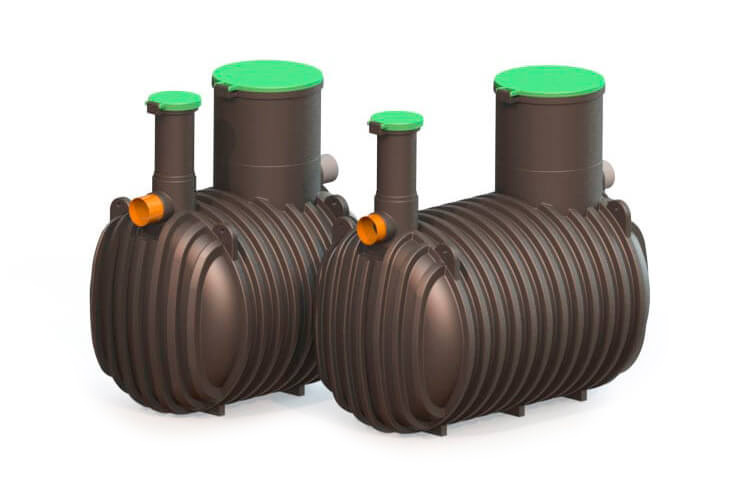Drainage treatment plant
The on-site sewage treatment plant — drainage treatment plant with infiltration system is designed to treat domestic sewage in areas without sewers, and it is successful in replacing concrete septic tanks. The essence of infiltration drainage is the system of underground land drains, introducing pre-treated sewage into the soil for further biological treatment. Drains enable the sewage to infiltrate into the soil over a large surface leading to its further treatment by the bacteria in the soil. It is treated by biological sorption, the retention of chemical ingredients aided by soil microbes and plant root systems.
Treatment plant operating processes
Sewage treatment in drainage treatment plants can be compared to the processes occurring in nature, and it occurs in two consecutive processes:
- Pre-treatment, which occurs in the drainage treatment plant through the processes of decanting (separation) and fermentation of the sludge aided by anaerobic bacteria, which results in partial sewage liquefaction. After passing the filter, pre-treated sewage is routed through the distribution well into the infiltration deposit. In the deposit, the sewage is treated as a result of biological and chemical aerobic processes.
- Infiltration drainage is the second stage of the aerobic sewage treatment. Made of tunnels, it enables the installation of the treatment plant in a small area and a significant reduction of project labour intensity. The suitable design of drainage tunnels provides proper aeration of the sewage, which is necessary for the growth of the biological film, responsible for proper sewage treatment.
Sewage parameters after both processes meet Polish and EU regulations.
Our range includes all kinds of tank top extensions, expansion telescopes, covers, distribution wells, control units, drainage pipes, infiltration tunnels and filters for treatment plants.
Specifications
Technical description
Table of available sizes of drainage sewage treatment plants.
Model, capacity, population equivalent, daily amount of sewage (m3/day):
- Treatment plant 2000 | 2000 litres | 1-4 | 0.6
- Treatment plant 3000 | 3000 litres | 3-6 | 0.9
- Treatment plant 4000 | 4000 litres | 5-8 | 1.2
Advantages
- The drainage treatment plant has a suitably ribbed tank with vertical ribs on the end caps (unique design solution), which ensures high mechanical strength,
- The tank (sedimentation tank) design and parameters meet the harmonised standard PN EN 12566-1,
- The tanks are manufactured using a cutting-edge rotational moulding (rotomoulding) machine, which ensures full control over the heating process and maintains proper oven and cooling temperatures. This type of machine ensures high material strength and production repeatability,
- The sedimentation tank is equipped with two stacks, one for tank purging and one for filter installation.
Environmental protection
- The septic tanks are 100% recyclable and the raw material is re-usable,
- They do not consume electrical energy.
Applications
- Holiday homes,
- Single- and multi-family houses,
- Resorts,
- Small enterprises,
- Camp sites,
- Tent sites, etc.


